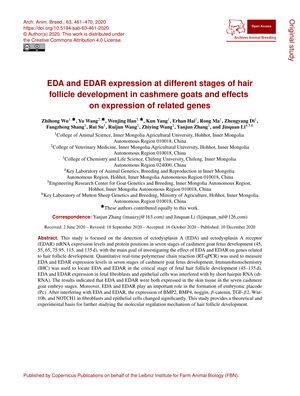EDA and EDAR Expression at Different Stages of Hair Follicle Development in Cashmere Goats and Effects on Expression of Related Genes
December 2020
in “
Archives animal breeding/Archiv für Tierzucht
”

TLDR EDA and EDAR are important for hair follicle development in cashmere goats and affect other related genes.
In the 2020 study, researchers investigated the expression levels and locations of ectodysplasin A (EDA) and ectodysplasin A receptor (EDAR) during seven stages of hair follicle development in cashmere goat fetuses (at 45, 55, 65, 75, 95, 115, and 135 days). They used quantitative real-time polymerase chain reaction (RT-qPCR) to measure mRNA levels and immunohistochemistry (IHC) to determine the protein positions of EDA and EDAR. Additionally, they used short hairpin RNA (sh-RNA) to interfere with the expression of these genes in fetal fibroblasts and epithelial cells. The study found that EDA and EDAR were expressed in the skin tissue at all seven stages and were crucial for the formation of the embryonic placode (Pc). Interference with EDA and EDAR expression significantly altered the expression of several genes related to hair follicle development, including BMP2, BMP4, noggin, β-catenin, TGF-β2, Wnt-10b, and NOTCH1. These findings contribute to the understanding of the molecular regulation of hair follicle development.





